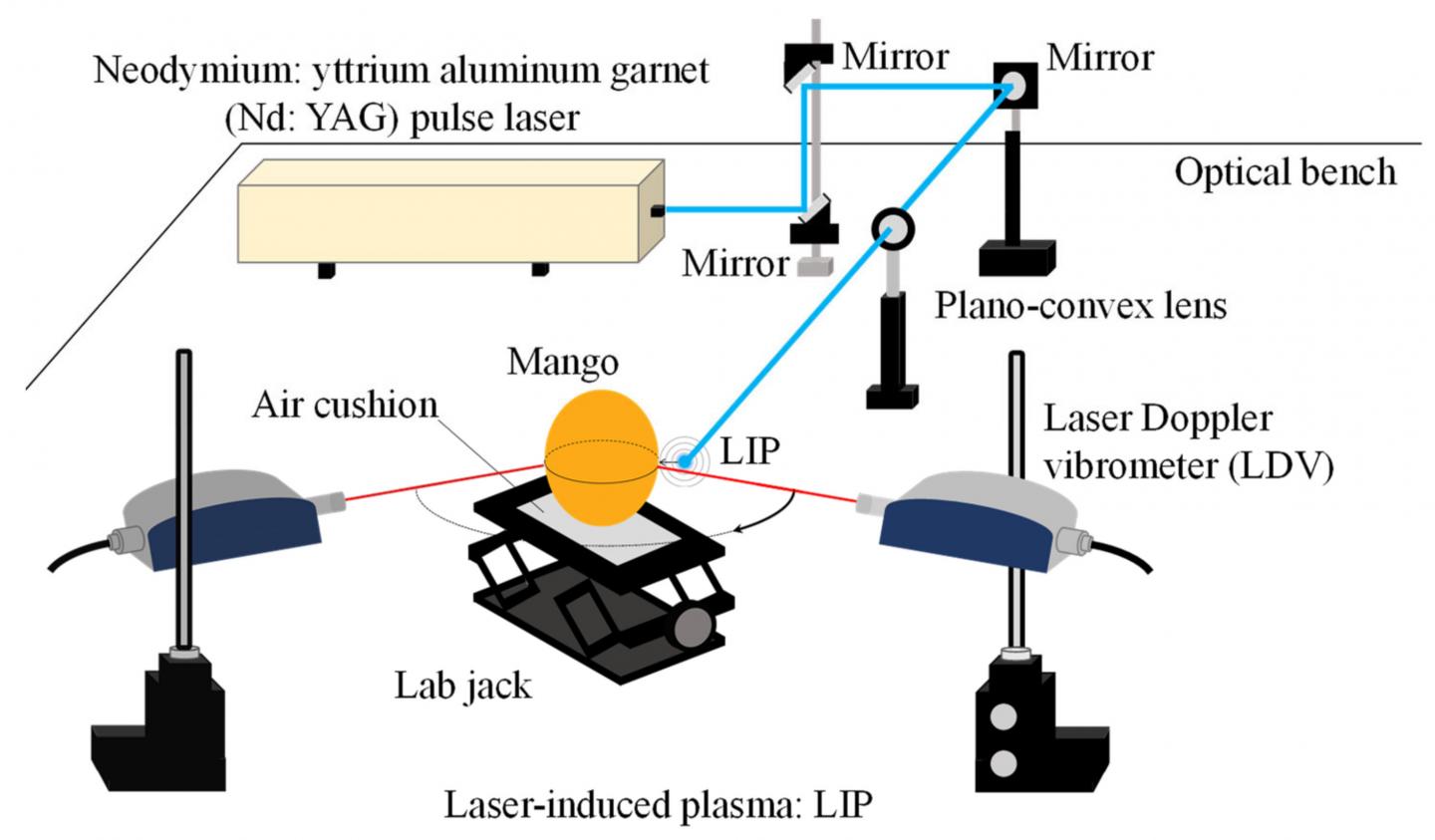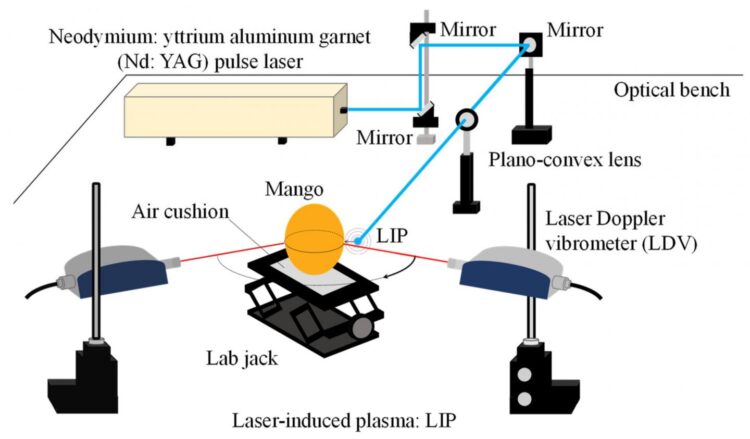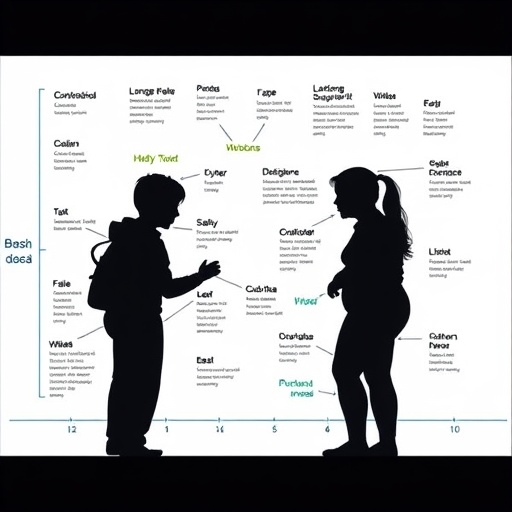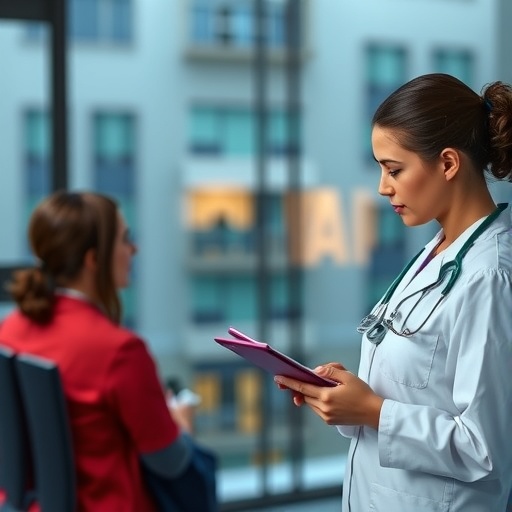Scientists develop convenient technique to measure ripeness using laser-induced plasma shockwaves and the ensuing vibrations on the fruit’s surface

Credit: Shibaura Institute of Technology
Most people are probably familiar with the unpleasant feeling of eating overripe or underripe fruit. Those who work in agriculture are tasked with ensuring a timely harvest so that ripeness is at an optimal point when the fruit is sold, both to minimize the amount of fruit that goes to waste and maximize the quality of the final product. To this end, a number of techniques to assess fruit ripeness have been developed, each with their respective advantages and disadvantages depending on the type of produce.
Although biochemical and optical methods exist, mechanical techniques are the most widely used. They indirectly assess ripeness based on the fruit’s firmness. In turn, firmness is quantified by observing the vibrations that occur on the fruit when mechanical energy is accurately delivered through devices such as hammers, pendulums, or speakers. Unfortunately, these approaches fall short for softer fruits, which are more readily damaged by the contact devices used.
In a recent study published in Foods, a team of scientists from Shibaura Institute of Technology (SIT), Japan, addressed this issue through an innovative method for measuring the firmness of soft fruits using laser-induced plasma (LIP). This work is a sort of follow-up of a previous study in which LIP was used to quantify the firmness of harder fruits.
But what is LIP and how is it used? Plasma is a state of matter similar to the gaseous state but in which most particles have an electric charge. This energetic state can be produced in normal air by focusing a high-intensity laser beam onto a small volume. Because the generated plasma “bubble” is unstable, it immediately expands, sending out shockwaves at ultrasonic speeds. Professor Naoki Hosoya and colleagues at SIT had successfully used LIP shockwaves generated close to the surface of apples to excite a type of vibration called 0S2 mode, colloquially referred to as “football mode vibration” because of how the resulting deformation looks on spherical bodies. They then verified that the frequency of the 0S2 mode vibrations was correlated with the firmness of the fruit.
However, soft fruits do not exhibit 0S2 mode vibrations, so the team had to analyze an alternative type of oscillation: Rayleigh waves. These are waves that occur exclusively on the surface of bodies without penetrating far into the interior. Using Kent mangoes, a setup for generating LIP, and commercially available laser-based vibrometers, the scientists verified that the velocity at which Rayleigh waves propagate is directly related to the firmness of the mangoes. Because the propagation velocity markedly decreases with storage time, it provides a reliable way to indirectly assess ripeness.
The team went further and looked for the best position on the mangoes’ surface to determine the velocity of Rayleigh waves. Mangoes, as well as other soft fruits, have large seeds inside, which can alter the propagation of surface waves in ways that are detrimental to measurements. “The results of our experiments indicate that Rayleigh waves along the ‘equator’ of the mango are better for firmness assessment compared to those along the ‘prime meridian’,” explains Hosoya. The experiments also revealed that cavities within the fruit’s flesh or decay can greatly affect the results of the measurements. Thus, as Hosoya adds, they will keep investigating which is the best area to measure firmness in mangoes using their novel approach.
In short, the team at SIT has engineered an innovative strategy to assess the ripeness of soft fruits from outside. “Our system,” remarks Hosoya, “is suitable for non-contact and non-destructive firmness assessment in mangoes and potentially other soft fruits that do not exhibit the usual 0S2 mode vibrations.” Further refinement of such firmness assessment methods will hopefully make them more reliable and accessible for the agricultural industry. With any luck, their widespread adoption will ensure that fruits reach your plate only when the time is ripe!
###
Reference
Title of original paper: Soft Mango Firmness Assessment Based on Rayleigh Waves Generated by a Laser-Induced Plasma Shock Wave Technique
Journal: Foods
DOI: 10.3390/foods10020323
About Shibaura Institute of Technology (SIT), Japan
Shibaura Institute of Technology (SIT) is a private university with campuses in Tokyo and Saitama. Since the establishment of its predecessor, Tokyo Higher School of Industry and Commerce, in 1927, it has maintained “learning through practice” as its philosophy in the education of engineers. SIT was the only private science and engineering university selected for the Top Global University Project sponsored by the Ministry of Education, Culture, Sports, Science and Technology and will receive support from the ministry for 10 years starting from the 2014 academic year. Its motto, “Nurturing engineers who learn from society and contribute to society,” reflects its mission of fostering scientists and engineers who can contribute to the sustainable growth of the world by exposing their over 8,000 students to culturally diverse environments, where they learn to cope, collaborate, and relate with fellow students from around the world.
Website: https:/
About Professor Naoki Hosoya from SIT, Japan
Dr. Naoki Hosoya currently leads the Mechanical Dynamics Laboratory at SIT, where he performs research on various topics within the field of mechanical engineering, including vibration analysis and engineering, structural dynamics, soft actuators, non-destructive tests, and acoustic and modal analysis. He has authored over 140 published papers, some of which have been among the top 10 most read in their respective journals.
Funding Information
This study was partly supported by the Tojuro Iijima Foundation for Food Science and
Technology, grant number 25, and the Japan Society for the Promotion of Science for their support under Grants-in-Aid for Scientific Research Programs (Grants-in-Aid for Scientific Research (B), Project No. JP 19H02088).
Media Contact
Wang Yu
[email protected]
Original Source
https:/
Related Journal Article
http://dx.





